UT Establishes the Fariborz Maseeh Department of Civil … – The University of Texas at Austin
[ad_1]
UT Establishes the Fariborz Maseeh Department of Civil ... The University of Texas at Austin
[ad_2]
Source link
[ad_1]
UT Establishes the Fariborz Maseeh Department of Civil ... The University of Texas at Austin
[ad_2]
Source link
[ad_1]
Travelers who have already explored some of the world’s best-known architectural cities may be yearning to visit a lesser-known treasure next time around. Using data from surveys, Booking.com, the global leader in connecting travelers with the widest choice of incredible places to stay, found some of the world’s most surprising architectural hotspots, from peculiar, rural Italian villages to futuristic cityscapes in Brazil.
Built in just over three years, Brasilia is a peculiar but charismatic place, now listed as a UNESCO World Heritage Site. The city was designed by chief architect Oscar Niemeyer in the International Style of architecture — a technique that combines vast sheets of glass, steel, spacious interiors, no fussy details and a more elusive weightless quality. Touring its artistic buildings is like going to Disneyland for architecture enthusiasts.
Where to stay: Designed by the highly acclaimed architect Ruy Ohtake, the Golden Tulip Brasília Alvorada boasts three tennis courts, a spa and two stylish swimming pools. It’s just over half a mile away from the Palácio da Alvorada.
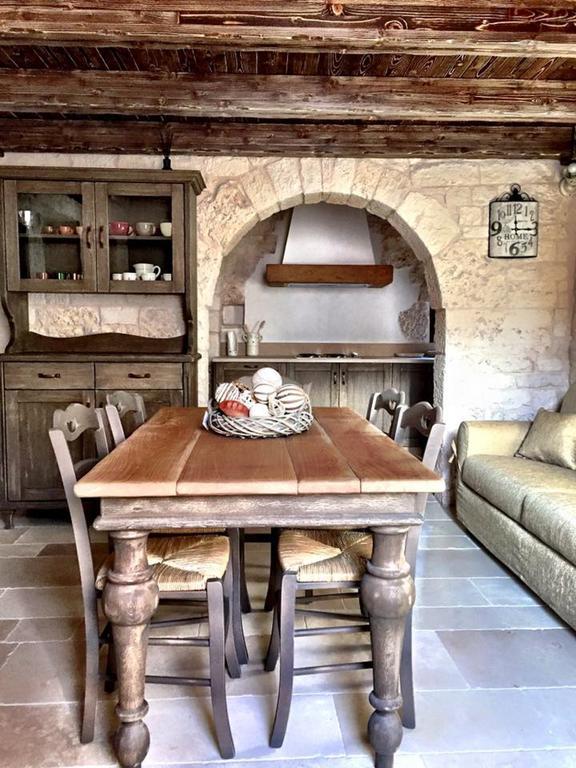
This small Apulian town is an architectural oddity. Its inhabitants live in trulli, dry stone huts with whitewashed walls and conical, limestone roofs that were built in the 14th century. The white tips of the roofs glisten in the sun, and the huts are all draped in wisteria and potted plants, making the setting feel almost fictional.
Where to stay: The family-run Trulli e Puglia Resort offers unique accommodations in traditional stone buildings typical of Alberobello. The beautifully restored houses have a kitchenette, while guests can buy keepsakes from Puglia at the resort’s own shop.

East of Paris and near the border with Germany you’ll find the secret gem Nancy. While it may not attract as many tourists as the Champs-Élysées, this picturesque town has many fine examples of elaborate French architecture. Baroque and art nouveau palaces are embellished with 18th-century details, gilded wrought iron gates and rococo fountains, while the main square is an immaculate, symmetrical and serene space.
Where to stay: Located in the heart of Nancy, Maison d’Hôte de Myon boasts contemporary décor in an 18th-Century building. A continental breakfast is served each morning, while cooking lessons are available upon request. There’s also wine tasting in the cellars.
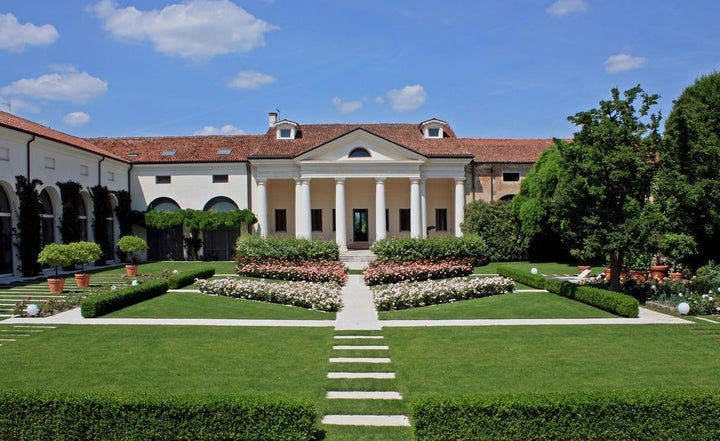
Set amid the dark green, sun-soaked hills of northern Italy, Vicenza is a masterpiece by 16th-century Italian architect Andrea Palladio. Lesser-known than neighboring Venice or nearby Bologna, Vicenza offers fewer tourists and untouched Italian architecture. Rustic villas and classicist town buildings characterize the region, decorated by magnolia trees and vines covering handsome porticoes and balustrades.
Where to stay: Located in the countryside, a 15-minute drive from Vicenza’s historical center, the Casa Barbieri Country House features modern accommodations surrounded by beautiful gardens, a sauna and a sun terrace with sun loungers.

A little-known city in New Zealand, Dunedin is an undiscovered architectural treasure and is often called the Edinburgh of the South, with its Scottish heritage evident in its ample Victorian and Edwardian architecture. The ornamented facade of the Edwardian railway station, made from dark basalt and contrasting limestone, with beautiful granite pillars, a tower and a magnificent central hall is a must-see.
Where to stay: Beechwood Boutique Accommodation offers tastefully decorated self-catering accommodations with free onsite parking, only a five- minute drive from the center of Dunedin.
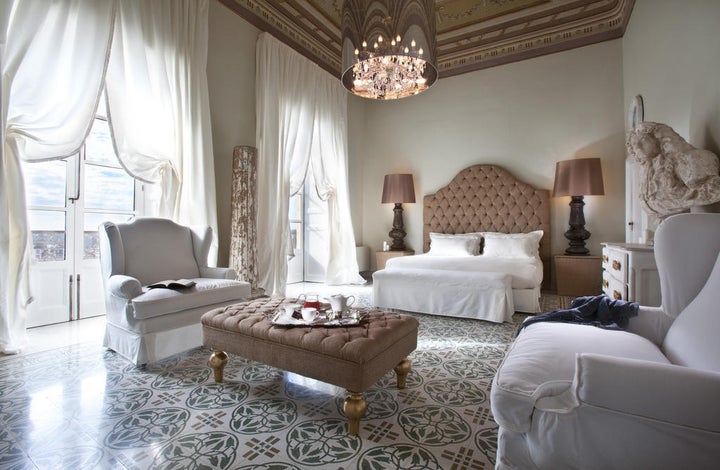
Noto is an ethereal, 18-Century city made entirely of honey-hued limestone on the sun-drenched island of Sicily. While it’s not a household name, Noto is perfectly set up for tourists, especially architecture enthusiasts. The town’s urban center was meticulously planned, and there are countless points from which you can enjoy incredible panoramic city views. Don’t miss the soft golden glow of the regal Baroque architecture under the setting sun.
Where to stay: Boasting a free bar corner and a panoramic terrace, the elegant Seven Rooms Villadorata offers air-conditioned accommodations with luxury furnishings and fine fabrics, located in the center of Noto. An Italian-style buffet breakfast with international options is available upon request.
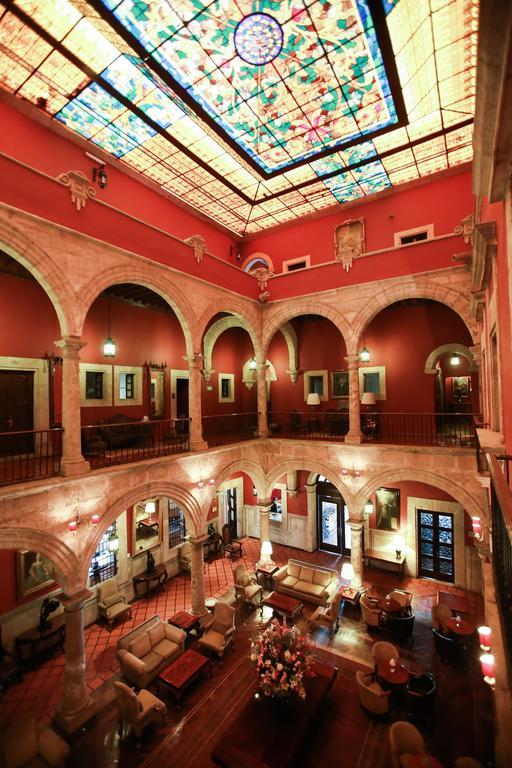
Though it’s not a common destination on most Mexican travel itineraries, Morelia is arguably one of Mexico’s most exquisite historic cities. Dating back to the 16th Century, its resplendent architecture displays a combination of Renaissance, Baroque, and Neoclassical style. All built in local pink stone, the glittering interiors of the churches and the impossibly grand Morelia Cathedral are shining examples.
Where to stay: Situated just more than 300 feet from Morelia Cathedral, the historic Virrey De Mendoza offers elegant, colonial-style rooms, a cocktail bar with a pavement terrace, a restaurant serving typical Michoacan dishes and international haute cuisine and a free welcome cocktail on arrival.
HuffPost Brand Forum is a paid program that allows companies to connect directly in their own words with HuffPost readers. For more information on Brand Forum, please contact BrandForum@huffpost.com.
[ad_2]
Source link
[ad_1]
“This whole thing is a load of cobblers!” huffed a flustered Boris Johnson, sitting at his round table in London’s City Hall on Thursday afternoon. “We need to get on and build this bridge … you just cannot bear the idea that a great project is going ahead. That is what this is all about. A load of cobblers.”
It was the surreal climax to what felt like something of a festive garden bridge pantomime. The fairy lights of a Christmas market twinkled through the windows while tourists shuffled along the south bank clutching cups of mulled wine, oblivious to the heated debate going on inside the chamber. The mayor had been summoned, along with the head of Transport for London Mike Brown and its planning director Richard de Cani, to explain themselves to the Greater London Authority’s Oversight Committee over the murky genesis of the proposed garden bridge. And Boris, chief bridge booster, was getting increasingly hot under the collar.
“The whole tenor of this conversation is completely out of whack!” he barked. “You’re trying to cast a cloud … you’re just a bunch of—”
The cross-party committee was here to get to the bottom of why the garden bridge project has followed such an unconventional, fast-tracked process since Joanna Lumley first wrote to Johnson in 2012 with an idea for a fairytale crossing. Following a calm, level-headed line of questioning, they asked how the mayor first heard of the bridge idea; if he knew Lumley was an Associate at Heatherwick Studio [the bridge’s architect] when they met; how many meetings they’d had before the official tender was launched; why TfL’s own legal advice about how to procure the project was ignored; and why the strong criticisms of the process in the internal audit were removed.
It was a forensic grilling, aided by a weighty stack of confidential documents released after countless Freedom of Information requests, that was batted back by a combination of Boris bluster and procedural admin-speak from Brown and de Cani.

The chief contention hangs over how Heatherwick was selected for the project, and the suggestion that his scheme was a done deal from the start – which was a concern of TfL’s own legal team. “We are aware that Thomas Heatherwick has already raised with the GLA and TfL the possibility of a garden bridge,” TfL’s lawyers wrote in January 2013, in a letter giving advice for procuring “specialist design services” for the project. “Care will be needed to ensure that, particularly in relation to timing of the competition and its specification, other bidders have an equal opportunity to pull together all the relevant disciplines and to put their ideas forward.” The letter goes on to add that “it will be important to ensure that is not, and does not appear to be, the case that decisions have already been made about the proposed structures.”
The advice is crystal clear: “The procurement of the design team for the bridge will need to be subject to competition through OJEU [the EU public sector procurement mechanism].”
But that didn’t happen. Instead, TfL decided to split the process in two. In February 2013, it ran a small tender process to procure a design advisor to “help develop the concept” (which was capped at £60,000 to avoid going through the full OJEU process). Heatherwick was selected, receiving a higher score for bridge design experience than two other experienced bridge architects. His submission, which was also released as part of a FOI request, is not a feasibility study at all, but merely an elaboration of his own garden bridge design, with Lumley listed as an Associate of the studio.
Then in April 2013 a second tender was issued “to develop the technical design of the bridge, to enable a planning application to be submitted”. With a contract value of £8.4m, the process used the official TfL Engineering & Project Management Framework and went through the proper formal stages of Expression of Interest and Invitation to Tender. Engineering giant Arup was duly appointed – then subcontracted Heatherwick to its team. The contract with TfL ended in April 2015 and the project was transferred to the Garden Bridge Trust to deliver.
When pressed over why this unconventional route was chosen, as opposed to the one advised by TfL’s own lawyers, de Cani said: “The circumstances had changed. The advice was clearly not relevant because we were doing things differently.” He assured the committee that they took additional legal advice over the new process.
The original advice, he said, was given on the basis that TfL might run the project from start to finish, though that later changed. “That wasn’t the approach we adopted because there was the opportunity to get the private sector to pay for most of the project,” he said, “and that’s where the trust came forward.”
Perhaps this all sounds fair enough – unconventional and not following due process, but a pragmatic response to changing circumstances. Except that his explanation doesn’t quite tally with the timeline.
The Garden Bridge Trust was founded in October 2013: it simply didn’t exist when the tender process changed. The idea for a trust was first mentioned to the TfL board in July 2013, in the Commissioner’s report on the project. The report also specifically states that TfL would be responsible for the development and “enabling costs associated with securing the necessary consents and approvals” – ie it would run the project to planning permission stage, which is exactly what the £8.4m Arup contract represents. There was no suggestion that this stage of work would ever be handled by a private trust. And even if TfL had envisaged that the project might be handed over to a trust following planning permission being secured, this would in no way represent a “change in circumstances” around the procurement, as de Cani claims.
It might sound like a minor point of procedural detail, but it adds increasing weight to the suggestion that the entire process was rigged to allow Heatherwick’s proposal to prevail – an allegation that TfL continues to deny. Meanwhile, other questions were skimmed over with theatrical prevarications and hazy recollections. Master of misdirection, Johnson kept leading the conversation off-topic, trying to recall whether the delightful model Lumley had first shown him was made of glass or wood. Either way, it was very beautiful. And the lovely Joanna is a hugely public spirited person, who has been doing all of this for free, and doesn’t deserve to have her name dragged through the mud. And he couldn’t quite remember if she or Heatherwick had accompanied him on a 24-hour trip to San Francisco in January 2013 to try and secure sponsorship for the bridge – a trip which cost the taxpayer more than £10,000.
“You don’t start lobbying for investment in a specific scheme when it has not been selected unless you are absolutely certain of the outcome,” said committee member Caroline Pidgeon after the hearing. “When the mayor made this lengthy and expensive trip there were no official plans by TfL for a garden bridge. The tender document for an initial design of a pedestrian footbridge had not even been published. It is mockery to claim that it was an open and fair competition when the Chair of Transport for London was already flying around the world seeking investment for one proposal.”
In the huffing, puffing, insult-throwing court of Boris, the real reason for the garden bridge (and the speed at which it has been bulldozed through the system) became clearer than ever. TfL has always framed the project as a crucial transport link, not a private tourist attraction, nor a mayoral vanity project. But, bathed in a festive purple glow beneath City Hall’s chamber, Boris finally delivered his revealing pantomime soliloquy. “A great city like London has to continually refresh its offer,” he said. “It’s important that we don’t rest on our laurels, but continue to adorn the city with things that will attract visitors … and to get it done within a four-year mayoralty is a very challenging thing.”
[ad_2]
Source link
[ad_1]
Ovenecká 33 is a unique apartment in Prague, Czech Republic, where the design is approached as an art installation, like an immersive experience designed by creative Tereza Porybná and Objektor architekti. Porybná has always been fascinated by the art of connection, whether it’s connecting people or exploring the boundaries between different realms, all while pushing the limits. Her vision for Ovenecká 33 is a space that transcends the ordinary, a place where public and private spaces intertwine, and a home that is ever-evolving, just like life itself.
Walking through the doors of Ovenecká 33 is like stepping into a world full of creativity. Porybná’s collaboration with Objektor architekti, led by Jakub Červenka, Václav Šuba, and Vojtěch Šaroun, brought her vision to life. Initially inspired by the likes of Luis Barragán, Valentina Schlegel, and Bijoy Jain, the project soon took on a life of its own, becoming a space with unique design elements.
Some of the more captivating features of the apartment are its hidden corners and geometric details. The unique interior reveals itself in layers – there’s a home throne, a kitchen that feels like a cave, and a secret doorway in the library. Various shaped niches are carved into the walls, while geometric shapes of stone are embedded into the floors like a giant mosaic.
The horizontal nature of the space offered an unobstructed world for the designers’ imaginations. They conceived the new design as “living scenography of changing and permanent backdrops.” A central core helps create various pathways and unexpected viewpoints, while the sun’s movement continuously changes the patterns of light on the stucco walls.
The main living space is dominated by a massive concrete island that serves multiple purposes.
Ovenecká 33 isn’t just an apartment – it’s also designed as an art gallery. Porybná’s dream is to share the space with creators and invite them for artist residencies, ensuring that the apartment remains in a state of perpetual transformation.
While the apartment is predominately filled with shades of gray, additional colors are brought in, along with warm woods, to make the space more cozy and livable.
A small, minimalist bathroom explodes with colorful light reflections through a stained glass window.
The light-filled entryway leads to a hallway with a built-in throne clad in woven textiles, which doubles as a piece of art.
Photography by BoysPlayNice.
[ad_2]
Source link
[ad_1]
Houston police arrested an intoxicated man with a small cache of weapons in his hotel room early Sunday, officials said.
Police later identified the man as 49-year-old Russell Lawrence Ziemba. Officials interviewed Ziemba hours after the arrest, and determined he had “no unlawful intent” to use the weapons, tweeted Houston Police Chief Art Acevedo.
Police had responded to a call for “urgent” backup from an officer at the Hyatt Regency hotel in downtown Houston around 1:30 a.m. Sunday, an officer at the Houston Police Department Command Center told HuffPost.
The officer initially attempted to arrest the “drunk and belligerent” man for trespassing, but requested help from other officers after discovering ammunition in his hotel room, Lt. Gordon MacIntosh told the Houston Chronicle.
Officers then “located multiple firearms,” the HPD command center officer told HuffPost. The weapons include an AR-15, a shotgun and a handgun, according to local NBC affiliate KPRC. Investigators also located and examined his vehicle.
Ziemba faces charges of assaulting a peace officer and criminal trespassing, the Houston Police tweeted.
The incident occurred hours before the Hyatt Regency’s massive New Year’s Eve party, which spans four floors and a 50,000-balloon drop at midnight.
Hyatt Regency Houston was “fully cooperating” with the police investigation, Tom Netting, the hotel’s managing director, said in a statement.
“The safety and security of our guests and colleagues is our top priority, and consistent with the hotel’s prepared security plans, heightened measures are in place on New Year’s Eve,” Netting said.
This story has been updated with latest comments from police.
[ad_2]
Source link
[ad_1]
In any sane universe, something called the Housing and Planning Bill might safely be assumed to stimulate house building and improve planning. But the bill, which receives its third and final reading in the House of Commons today, does exactly the opposite of what it says on the tin. It will exacerbate the housing crisis and further enfeeble the planning system in ways we cannot yet comprehend.
The primary assault on social housing has been much discussed in these pages. The bill’s flagship measure – promoted at ownyourhome.gov.uk – will replace genuinely affordable homes with public subsidies for property investors. Rather than building homes for affordable rent, the legislation will force local authorities to build “Starter Homes” for first-time buyers. Capped at £450,000 in London and £250,000 in the rest of England, these homes will be unaffordable for people on average incomes in over half of the country, as Shelter has pointed out. Buyers will be free to sell their assets after five years at full market value, thereby minting a new generation of property speculators and removing any long-term benefit for future first-time buyers.
In addition to this, the bill will extend Right to Buy to housing associations, further depleting the number of homes for social rent. It will also compel local authorities to sell their highest value housing stock and pass the proceeds on to central government. Given that these high value areas are already subject to the greatest pressures on affordable housing, the effect will simply be to remove resources from the places that need it most. It will see British cities divided further into segregated enclaves for rich and poor.
The bill will bring an end to secure lifetime council tenancies, replacing them with two to five-year tenancies, and force those with a total household income of over £30,000 to pay market rents – hitting low-paid working families hardest.
In short, it is a raft of misguided measures that will only increase housing inequality. As campaign group Architects for Social Housing – demonstrating outside Parliament today – puts it, the bill is “an extremely subtle and duplicitous piece of legislation that in almost every aspect does something very different, if not the direct opposite, of what it is claiming to do.”
But the planning side of the bill has yet to receive the attention it deserves, in either the Commons or the national media. The proposed changes are shrouded in a haze of intentional ambiguity, but they threaten to eat away at the last shreds of the democratic process that safeguards how our communities are made, putting power instead in the hands of developers.

The most radical measure is the introduction of automatic planning permission in principle on sites allocated for development, without applications being subject to the usual rigours of the planning process. When the idea was mooted in October, ministers suggested it would initially be limited to proposals for housing on brownfield land but nothing in the legislation prevents it from being applied to any kind of development on any site.
“It is extremely dangerous,” says Hugh Ellis, policy director at the Town and Country Planning Association. “It could apply to all forms of development – for example, fracking could easily be given ‘permission in principle’ as part of a minerals plan. You can’t make a decision in principle about a site until you know the detail of its implications, from flood risk appraisal to the degree of affordable housing. Giving permission in principle would fundamentally undermine our ability to build resilient, mixed communities in the long term.”
Ellis fears that the bill marks the introduction of a “zonal” planning system, along US lines, whereby land is zoned for particular uses at a broad-brush scale and permission granted without the finer-grain negotiation of applications on a case-by-case basis, which has always defined the English postwar planning system.
“Zoning is one of the major contributors to the economic and social segregation of cities in America,” says Ellis. “If the government is going to make such a fundamental change to the planning system there needs to be an enormous amount of public debate and research. The future of British cities is at stake here, but there’s been no white paper and no public discussion at all.”
Lack of debate seems to characterise the entire bill, which saw several crucial amendments slipped in under the radar just before Christmas. In a change that opens the door for the privatisation of the planning system, communities secretary Greg Clark added a clause in December to allow the “processing of planning applications by alternative providers”. Rather than submitting a planning application to the local authority, it suggests that developers could assign a “designated person” to process the application for them instead.

Dr Bob Colenutt, planning expert at the University of Northampton, describes the move as “iniquitous”. “It will replace a public-sector ethos with a developer-led ethos,” he says. “The ‘designated persons’ are likely to be consultants who also work for the private sector, which introduces probable bias and reduces the public scrutiny trail. And it is very likely to reduce the right that the public has to make comments on planning applications.”
In the same way that developers’ financial viability assessments have been hidden from public view, it could mean that the entire planning process happens behind closed doors, with applications assessed by private consultants, paid for by the applicants.
“The question is, what problem is this really trying to solve?” asks Janet Askew, president of the Royal Town Planning Institute. “Local authority planning departments are critically underresourced, so if it’s a question of them being too slow then the government needs to increase their capacity, not strip it away further.”
Elsewhere in the bill, if local powers aren’t being handed out to the private sector, they’re being trampled by central government. Independent planning inspectors will be bypassed in a measure that lets the secretary of state intervene in the assessment of local plans. Another clause introduces a new power that will allow the government to produce plans for areas where it deems the local authority to be “failing or omitting” to do the work.
“It is all profoundly undemocratic,” says David Vickery, a recently retired senior planning inspector. “The bill represents a significant centralisation of powers by government to micro-manage planning, without thinking through the consequences. It reads like a panicked reaction to current low housebuilding rates, and the fact that the government doesn’t trust anyone other than itself to do the job. It proves that localism is dead.”
By further diluting the planning system in the name of “cutting red tape”, the government has picked the wrong target once again: the problem isn’t with planning, but with developers sitting on land. DCLG figures show that planning permission was granted for 261,000 homes in the year ending March 2015 (against the need for at least 240,000 homes per year), but only 125,110 homes were actually built. Put simply, 136,000 more homes were consented through the local planning system than were built by house builders. And, as a recent Guardian investigation revealed, the UK’s biggest developers have a land bank big enough for 600,000 new homes. It might be an idea to get them to use it. Instead, this bill represents a wholesale power grab, transferring both housing assets and planning powers from public to private hands in a drunken festival of deregulation.
[ad_2]
Source link
[ad_1]
In Bhilai, India’s tranquil landscape, Atelier Varun Goyal designed The Courtyard House by seamlessly fusing design and functionality. Created for two brothers, this unique home redefines modern living while celebrating the essence of togetherness and individuality. The Courtyard House project was envisioned as two interconnected yet distinct homes for two brothers. The central courtyard plays a pivotal role in uniting these homes and preserving their family bond. Careful discussions with the clients aimed to strike a balance between shared spaces and private living.
The central courtyard unfolds as a tranquil oasis, connecting the two homes and intertwining their stories. The clean white exterior is punctuated with black framed windows that complement the multilayered black tiled courtyard and water feature.
The Courtyard House embraces sustainability throughout. The central courtyard helps maximize cross ventilation and natural daylight to help reduce electricity consumption. Natural materials, like reclaimed teak wood, Indian marbles, and terrazzo floors made from marble waste, contribute to a more eco-friendly design.
Upon entering the foyer, white marble flooring sets the tone for each of the home’s modern aesthetic that’s unveiled the further into the houses one goes. The living area, with its black walls and large windows, provides an intimate ambiance with views of the lush greenery outside. The family space merges with an open-concept kitchen, inviting gatherings and interactions.
The interior showcases a minimalist and monochromatic color palette of black and white hues. This choice adds elegance and sophistication, providing a timeless backdrop for architectural elements and furnishings.
The floating black staircase features a pared back design while also making a visual statement in the open living space.
High ceilings and white walls help to maintain cool indoor temperatures, as the white surfaces reflect both heat and light.
Private bedrooms come with dressers and their own private bathrooms clad in Indian marble that’s complemented with teak wood details.
Photography by Pankaj Anand.
[ad_2]
Source link
[ad_1]
An Arkansas mosque has paid off the remaining court fines of a man who helped vandalize their sacred space ― doing its part to make sure he doesn’t have to serve any more jail time for the crime.
Hisham Yasin, social director of the Masjid Al Salam in Fort Smith, told HuffPost on Tuesday that his congregation had forgiven the convicted vandal, Abraham Davis, long ago. Paying the more than $1,700 in fines Davis still owed was a way to put that forgiveness into action.
Now, Yasin wants Davis move on with his life.
“He needs to keep going, don’t even look back. The back is gone,” Yasin said. “I look forward to seeing him work and study and become something in the future. And at that time, he’ll talk about what happened with him ... how he flipped his life from bad to good.”
Davis was one of three men arrested after the mosque was vandalized in October 2016. He drove to the mosque in his mother’s minivan and reportedly stood watch as one of his friends drew swastikas, curses, and the words “Go Home” on the building.
Davis has expressed deep regret for the crime, writing the mosque a letter of apology from jail.
The mosque leaders decided not to press charges against the men ― not wanting the act to destroy their futures. Still, Davis was convicted of a felony and burdened with about $3,200 in fines.
The story gained national attention after Davis and mosque leaders were profiled in a New York Times story in August. Al Salam received letters and pledges of support from their local interfaith community and from across the country. Yasin said one organization, the Jay Pritzker Foundation, gave the mosque a $25,000 donation. The amount took the congregation by surprise ― and re-energized its desire to help Davis.
Meanwhile, Davis was worried about paying his fines. And failure to meet the monthly payments could have resulted in more jail time, according to a follow-up story in the Times last week. Part of his debt was reportedly paid off by a Times reader. But the remaining $1,731 was donated by the mosque. Yasin said he brought a cashier’s check for that amount to the Sebastian County Courthouse on Dec. 11.
“I was honestly super happy,” Yasin said. “When we start something good, we have to finish it all the way.”
In last week’s Times’ story, Davis was described as being dumbstruck by the news that his debt had been paid.
“It’s a great weight being lifted off of my shoulders,” Davis told the Times. “And I don’t deserve it, but this act of kindness, it’s just, wow.”
For Yasin, reading about Davis’ shock was a confirmation that the congregation’s decision was the right thing to do.

“We need that shock for him, to stop all evil acts in the future,” he told HuffPost. “He’ll say, ‘Look at those people, I hurt them, I hurt their mosque, I hurt their God, and with all those bad things, they still showed me the most love I’ve ever received.’”
“That’s how we treat people in Islam,” Yasin said. “Islam is a love religion. Islam is peace.”
[ad_2]
Source link
[ad_1]
Design students have created a coat for refugees that can be reconfigured into a tent or a sleeping bag big enough to hold an adult and a child. The garment, which resembles a three-quarter length puffa jacket with a hood when worn, gives fresh meaning to the term “wearable technology”.
The brief was first suggested to the Royal College of Art in London by the clothing company Wall, and is the work of 10 master’s students between the ages of 22 and 26, who intend to crowdfund production costs and begin distributing the finished product by June.

The “wearable dwelling” is made from Tyvek, which is durable but extremely light and soft, permeable to air and water vapour and also rain-repellent. It is insulated with Mylar, a polyester film material also known as “space blanket” that is commonly used by marathon runners for protection. The garment has plenty of pockets for personal items.
“Lack of adequate, watertight shelter and warm, waterproof clothing is a major issue in refugee camps across Europe,” said Ruben van den Bossche, one of the students, who believes designers have their part to play in finding solutions to the problems faced by refugees in Europe’s biggest humanitarian crisis since the second world war. More than a million refugees arrived in Europe in 2015 – a four-fold increase on the previous year.“When people are forced to flee their homes due to conflict or persecution, they often leave with only the clothes on their backs and undertake what can be very long journeys in very difficult conditions,” said a spokesperson for the United Nations high commissioner for refugees.

“[We are] always looking at how design and technology can be used to improve our emergency response. With the proper testing, the RCA’s concept could be an innovative way to address the need for shelter for people who have lost everything.”
But Nick Harvey, of the voluntary health organisation Doctors of the World, expressed some doubts. “This garment, while being better than nothing, does not appear suitable for the harsh weather conditions many refugees face. It’s certainly not an adequate shelter for an adult and child,” Harvey said.
“It’s great that they’re trying to help. But it’s not going to be particularly effective if the temperature is minus 10 and you’re trudging through the Balkans. It looks more suitable for festival-going or possibly even for the UK homeless.”
The marketing plan for the coat is expected to include an option for festival-goers of “buy-one-for-yourself, give-one-to-a-refugee”, while its armless design is intended to prevent the garment being uncomfortable to wear in summer.
“I know that this could seem naive and fluffy,” said Harriet Harriss, senior tutor at the RCA. “But it was born out of a sense of powerlessness to help the people pouring out of Syria. As designers, we are doing what we can with what we have.”
[ad_2]
Source link
[ad_1]
Morris Adjmi, founder and principal of Morris Adjmi Architects, has found the sweet spot between traditional and contemporary architecture that delights both forward-thinking developers and history-minded preservationists. What Morris is best at is revitalizing post-industrial neighborhoods and historic districts with architecture that bridges the past and the present. MA specializes in interpreting the forces that shape cities to create buildings that may not feel like they’ve always been there, but like they should have always been.
Morris’s passion for historic and industrial architecture was formed by the cast-iron French Quarter balconies and Creole cottages in his hometown of New Orleans, Louisiana. “Growing up, I spent countless hours drawing the buildings, balconies, and ornate ironwork of the French Quarter,” he reminisced. “However, when I started my formal studies at Tulane, I came to understand that the city’s diverse and distinct buildings, as much as I loved them, belonged to a specific moment in time and were part of the city’s history.”
It was a pivotal realization that directed Morris’s philosophy moving forward. “I decided I didn’t want to imitate the buildings that I loved, but it felt essential to learn from them. So, I dedicated my thesis to investigating vernacular housing in New Orleans – Creole cottages, shotguns, townhouses – in order to find a deeper understanding of the type that went beyond historicism or style and could be used to develop an architecture that belonged to my moment in time; not just an architecture that resonated with me personally, but with twentieth-century New Orleans.”
Morris’s style was further refined in New York and Milan during a 13-year collaboration with Pritzker Prize-winning architect, Aldo Rossi. “Of all the architects I had studied up to that point, it seemed that Rossi’s sensibilities were closest to my own. When I met him I was certain of it,” Morris stated. “In 1980, I enrolled in the Institute for Architecture and Urban Studies in New York, specifically to take an advanced design workshop with Aldo. I had the good fortune to not only study with him that year, but to work with him soon after on a competition project in Milan. The job was supposed to last a few weeks, but a few weeks turned into a few years, and a few years turned into a professional partnership that lasted more than a decade.”
Morris Adjmi Architects was opened in 1997, built on a foundational experience wherein Morris updated a European approach into one more fit for the modern American city. Today, his work is known for its thoughtful historical engagement, interpretation of industrial forms, and creative expression of materials. MA’s integration of tradition and innovation has created a body of work that is sometimes subtle, often bold, and always deeply imbued with a sense of place and purpose.
The architect’s love of process and personal experience have also pushed him towards art. Morris has developed a series of small sculptures over the past few years, objects shaped in clay that are then cast in bronze. “It’s a fun project that allows me use my mind and hands in a different way,” he shared.
“There’s always stimulation in art and I love to draw on that in my design process. Our office is full of Rossi’s artwork and early prototypes, as well as more contemporary pieces from my personal collection,” Morris said. “To keep our space fresh and dynamic, MA’s Manhattan office has served as a space for rotating art exhibitions for the past 10 years or so, showcasing the work of painters, photographers, sculptors, and other artists whose ideas resonate with the firm’s values. These exhibitions not only enrich our practice, but also create a platform for connecting clients, artists, and others to inspire collaboration and build community.”
The exhibition program evolved naturally into an established in-house Art Services department in 2019, developing and delivering art programs that respond directly to the firm’s architecture and interior designs. It’s been catching on, and MA recently delivered significant art programs for two large multifamily projects: Front & York in Dumbo, Brooklyn and The Asher in Tampa [Florida]. There’s also something in the works for The Huron in Greenpoint, Brooklyn.
Today, Morris Adjmi joins us for Friday Five!
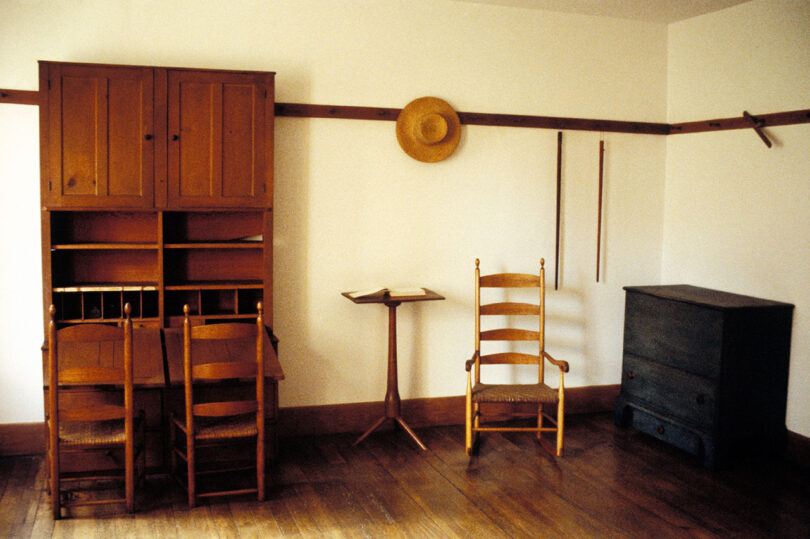
Hancock Shaker Village, Pittsfield, Massachusetts Photo:: Universal Images Group North America LLC / Alamy Inc.
In a fast-paced world driven by excess and instant gratification, Shaker design reminds me of the value of restraint and mindful consumption. Their furniture, architecture, and products showcase simplicity, economy, proportion, and honesty, blending both modern and traditional elements while remaining durable and timeless. Despite their minimalistic approach, Shaker pieces exude warmth and depth, telling a story and inviting us to appreciate the beauty of simple, thoughtful design. The design is minimal yet imbued with love and soul, reflecting qualities we should strive to create and live with.
My fondest memories as a teenager are sitting in my room listening to music and reading an encyclopedia. My appreciation for reading books has only grown. I love all kinds of books – fresh books that smell like ink and transport us to another world. Or the musty ones found at a neighborhood shop that are filled with picture plates tipped in. Books provide an escape but also a way to connect to others. A favorite of mine will always be The Adventures of Huckleberry Finn.
Music has the ability to transport us to a different time through memories of past listens or place/space through the music itself. For me, listening can be passive or active but it’s always therapeutic. I appreciate a wide range of music from ambient to punk to R&B to opera. An album that’s never left the rotation is The Velvet Underground & Nico.
Art is a constant inspiration for my architecture and a stimulus for thought and research. What I love about art is that it’s immediate and reflects who we are now and provides a way to connect us. Art is more and more reflecting our social consciousness, which is a good thing but in the end it’s still about beauty. Our office is filled with art, including pieces from my personal collection, such as the Marlon Mullen and C.J. Chueca works shown here.
Industrial landscapes always excite me – whether in a Becher photograph or seen from a window, like this factory I captured through a train window while passing through Perth Amboy, New Jersey. I love the history; the forms inspired by production and engineered for efficiency. I also love that these landscapes have transcended their original purpose. Sometimes active and sometimes fallow with nature reclaiming her space, I find them to be beautiful, nostalgic, and poetic.
This post contains affiliate links, so if you make a purchase from an affiliate link, we earn a commission. Thanks for supporting Design Milk!
[ad_2]
Source link